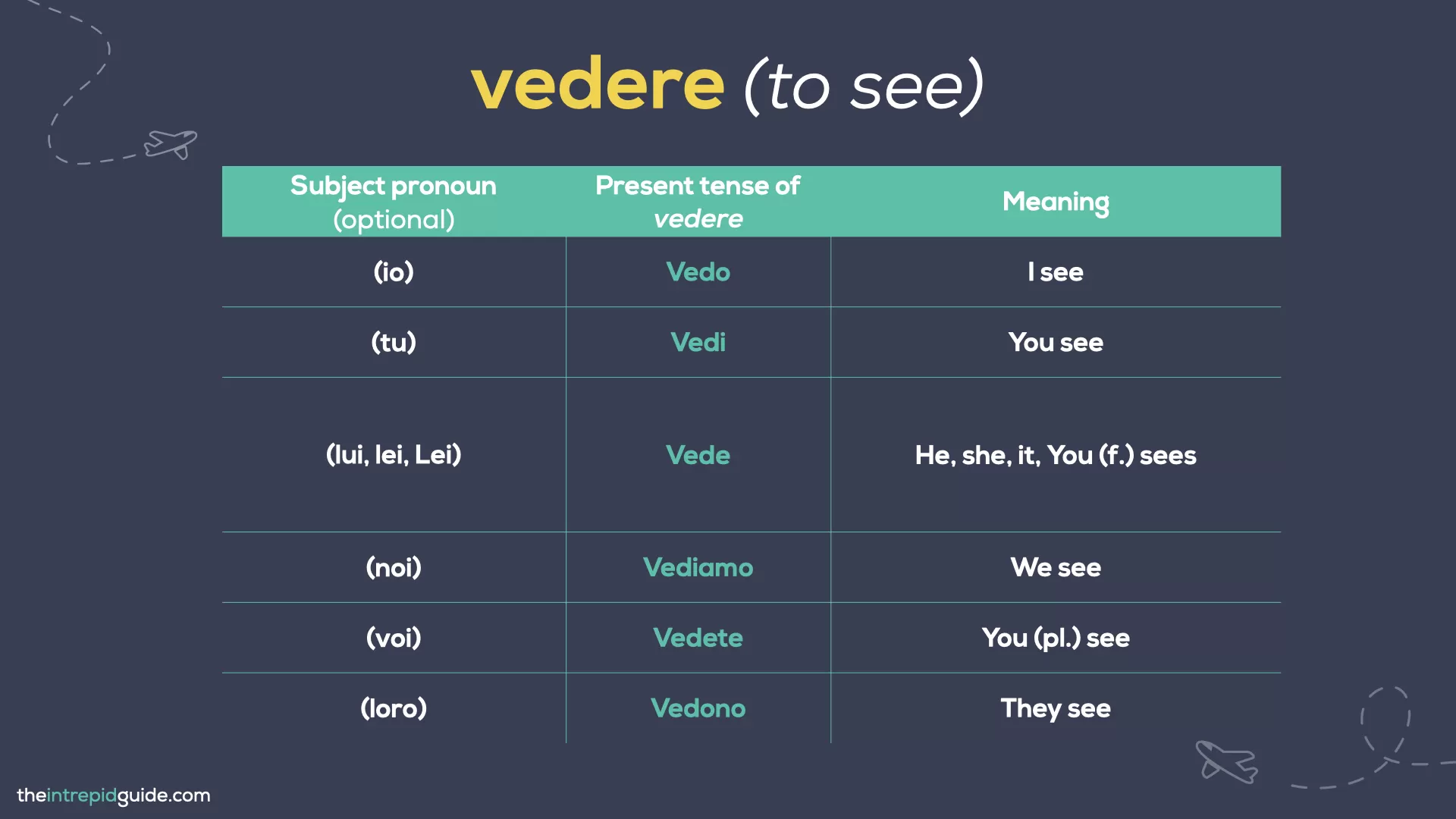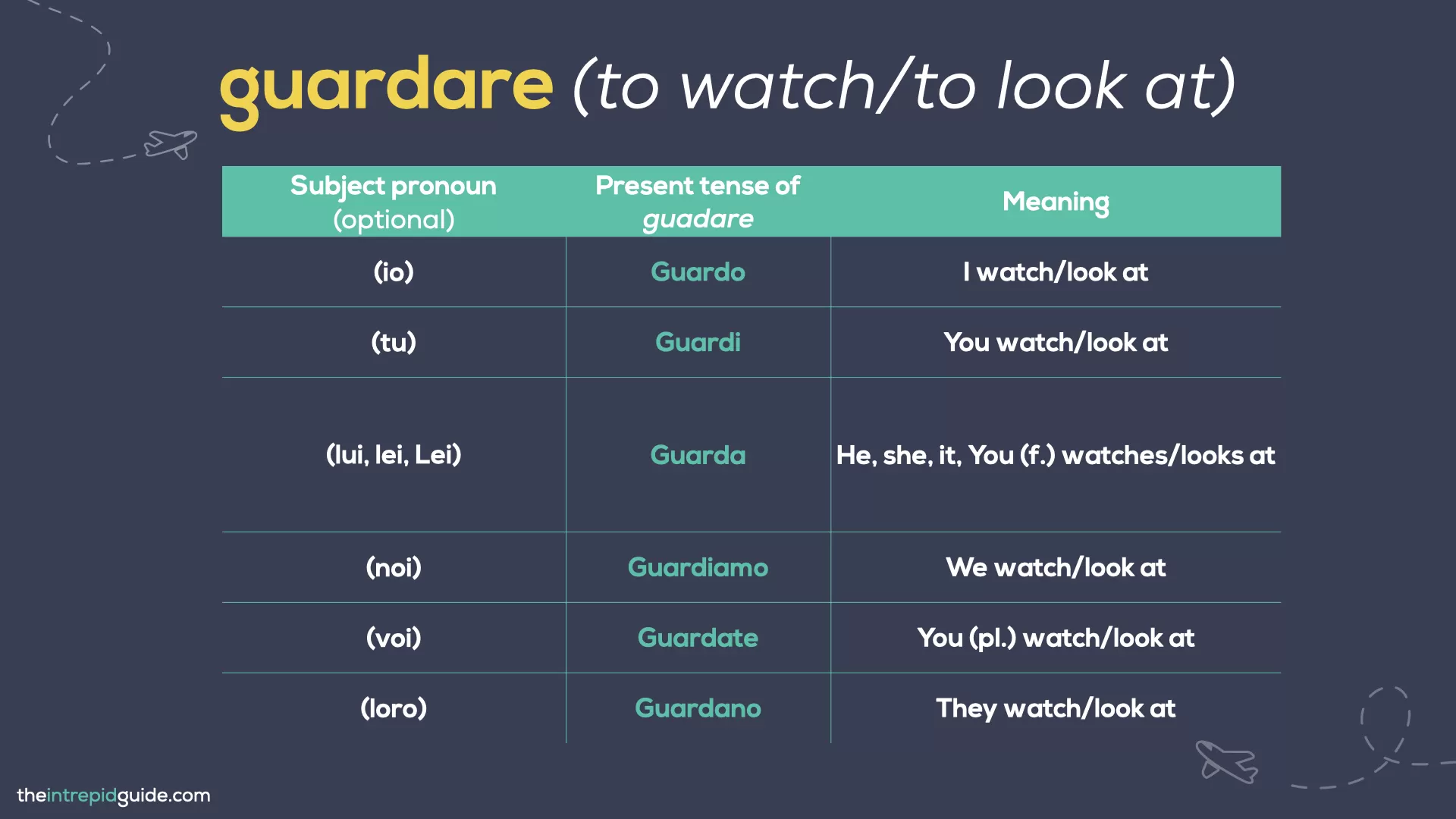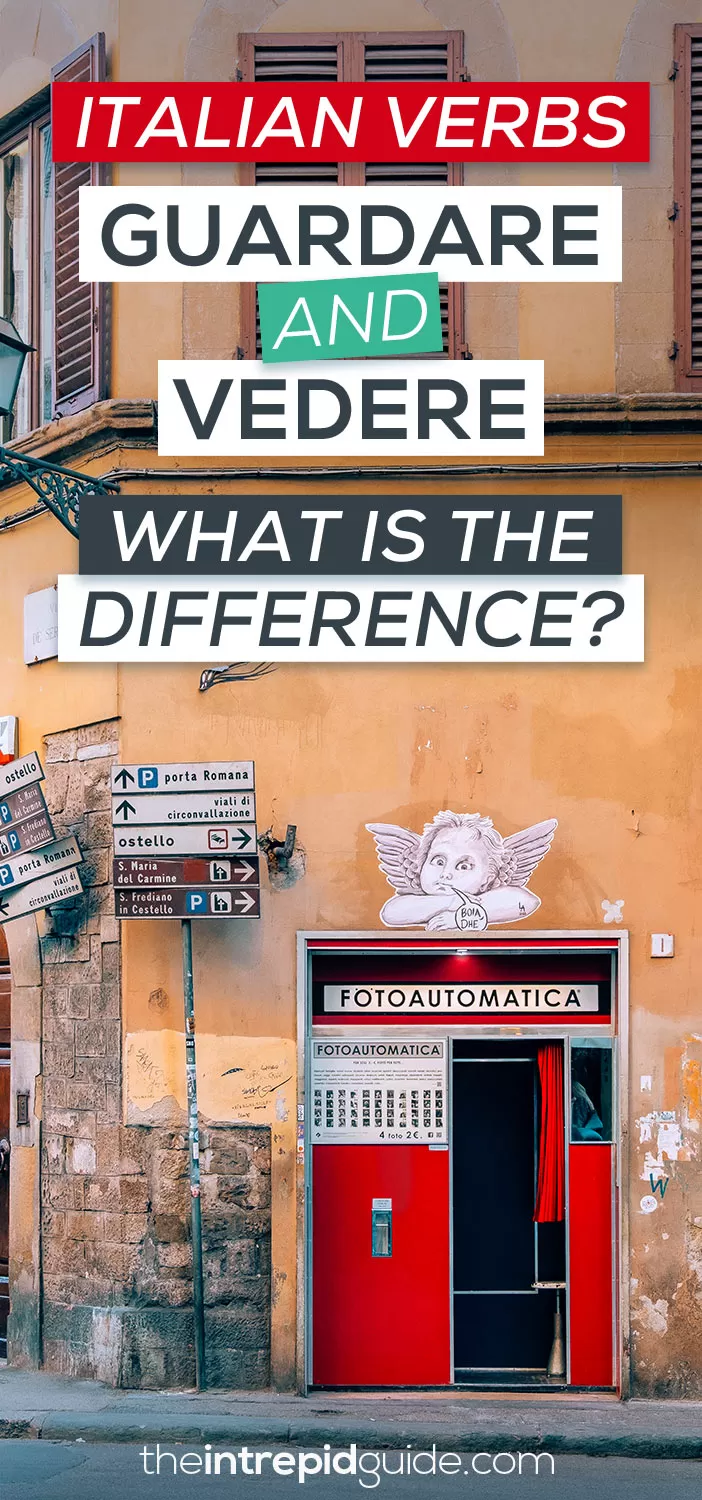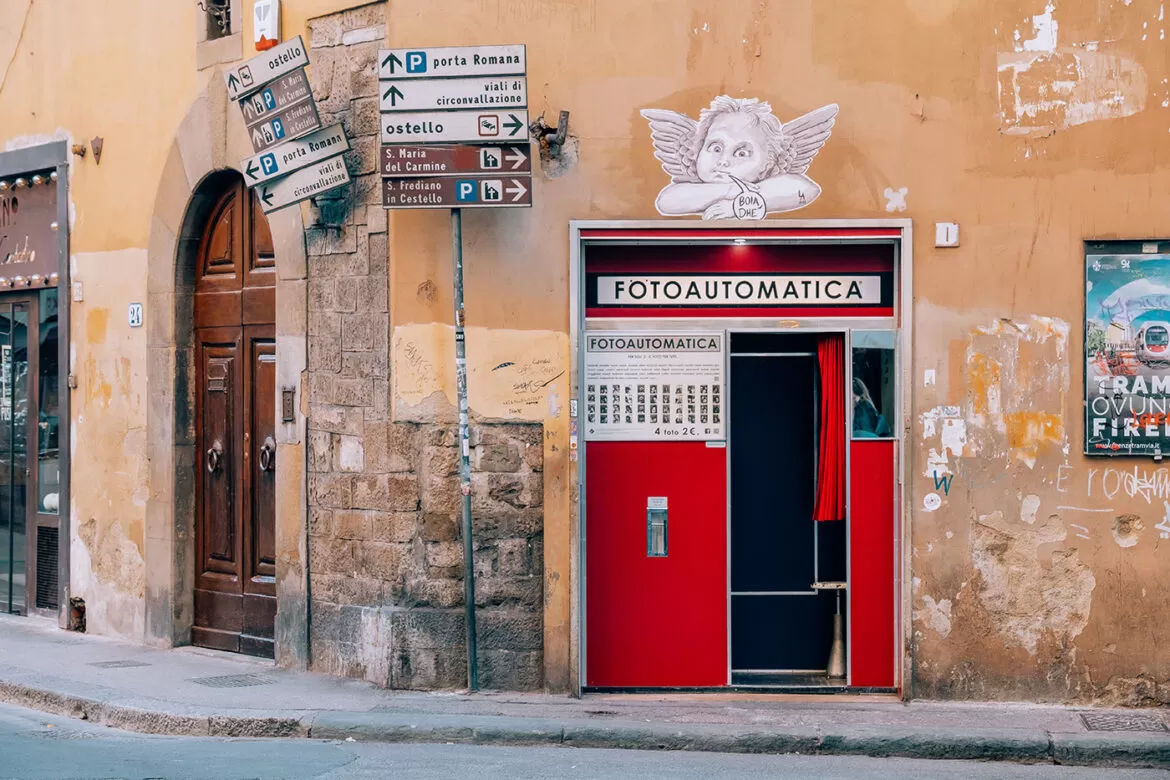Whether you’ve just started learning Italian or you’ve been at it for a while, I’m sure you’ve come across these two verbs many times: vedere and guardare.
You’ve probably wondered: when should I use vedere and guardare? Are they interchangeable? Is one verb used more than the other? Is there an equivalent in English for each one?
In this guide, I’ll show you what vedere and guardare mean, in which contexts they’re used, and how not to confuse them. There’s even a fun little quiz at the end so you can test your skills!
Iniziamo! (Let’s begin!)
What is the difference between GUARDARE and VEDERE?
 The short answer is: vedere means ‘to see’ while guardare means ‘to look at’ or ‘to watch.’ But there are some important nuances you should know about. Let’s go into more detail.
The short answer is: vedere means ‘to see’ while guardare means ‘to look at’ or ‘to watch.’ But there are some important nuances you should know about. Let’s go into more detail.
*Tip: For a list of common Italian verbs, get my free guide here. It includes a FREE PDF cheat sheet you can download and practice with.
The Italian verb VEDERE: a verb of perception
Let’s start with the verb vedere. Vedere means ‘to perceive with the eyes’. It is related to the perception of the external world through la vista (sight). We could say that the Italian verb vedere is the equivalent of the English ‘to see’ (indicating an involuntary, unintentional action).
Since it indicates an involuntary act, it is sometimes accompanied by expressions like per caso (by chance) or di sfuggita (briefly), e.g. Ho visto Paolo per caso/di sfuggita al supermercato ieri (I saw Paolo by chance/briefly at the supermarket yesterday).
When vedere is followed by a clause with che, in this case it means ‘to become aware of something’, to learn a piece of information through, for instance, the television, newspaper or social media, e.g. Ho visto che ti sei laureata, complimenti! (I saw that you graduated, congrats!)
Vedere is also used with the meaning of visitare (‘to visit’), as in ‘to see places/monuments’, e.g. Ieri ho visto i Musei Vaticani (Yesterday I saw/visited the Vatican Museums).
How to conjugate the verb VEDERE
Here is the conjugation of vedere in the present tense.

| Verb conjugation | English translation | |
|---|---|---|
| (io) | Vedo | I see |
| (tu) | Vedi | You see |
| (lui, lei, Lei) | Vede | He, she, it, see, You (f.) see(s) |
| (noi) | Vediamo | We see |
| (voi) | Vedete | You (pl.) see |
| (loro) | Vedono | They see |
Attenzione! In the passato prossimo tense (one of the most used past tenses in Italian), vedere has an irregular form: visto (we call this, the past participle).
Find out more about how to easily conjugate Italian verbs here or watch my video below.
Example sentences with VEDERE
Let’s look at these example sentences:
- Non vedo molto bene dall’occhio sinistro. (I can’t see very well from my left eye.)
- Hai visto che Maria si è sposata? (Did you see that Maria got married?)
- Il primo giorno a Roma abbiamo visto il Colosseo. (On our first day in Rome we saw the Colosseum.)
Other meanings of VEDERE
The reflexive form of vedere is vedersi, which can have different meanings: for instance, the literal meaning of ‘to perceive oneself’, e.g. vedersi brutto/bello (to see oneself ugly/good-looking); ‘to see oneself’ in the sense of ‘to picture oneself’, e.g. Tra 10 anni mi vedo ricco e famoso (In 10 years I see myself being rich and famous); or, with a reciprocal value, ‘to meet’, as in ci vediamo domani (see you tomorrow).
Idioms with VEDERE
Here are two common Italian idioms with the verb vedere.
The first one is: Occhio non vede, cuore non duole.
Literal translation: Eye doesn’t see, heart doesn’t hurt.
Meaning: What the eye doesn’t see the heart doesn’t grieve over.
The second one is: Il buongiorno si vede dal mattino.
Literal translation: The good day is seen from the morning.
Meaning: You can tell a good day from the morning.
The Italian verb GUARDARE: a verb of intention
Let’s move on to the verb guardare! While vedere refers to the perception of something, guardare refers to the intention, the act of turning one’s gaze toward something or someone, with more or less attention. It translates to the English ‘to watch’, ‘to look (at)’ (indicating a voluntary action).
It is often accompanied by adverbs: e.g. guardare attentamente (‘to look carefully’), guardare male (to give a bad look).
It is used in compound words indicating those assigned to custody or surveillance (e.g. il guardalinee, ‘lineman’), or objects with a protective function (e.g. il guardaroba, ‘wardrobe/closet/cloakroom’).
The verb guardare also means ‘to look after’, ‘to pay attention to something/someone’, e.g. guarda il mio cane fino al mio ritorno (look after my dog until I get back).
Guardare without… seeing? Since the main element of guardare is the intention, it doesn’t necessarily involve seeing, as in, perceiving things with your eyes. Look at the following example:
- Ho guardato ovunque ma non ho visto il tuo portafoglio. (I looked everywhere but I didn’t see your wallet.)
How to conjugate the verb GUARDARE
Here is the conjugation of guardare in the present tense.

| Verb conjugation | English translation | |
|---|---|---|
| (io) | Guardo | I watch/look at |
| (tu) | Guardi | You watch/look at |
| (lui, lei, Lei) | Guarda | He, she, it, You (f.) watche(s)/look(s) at |
| (noi) | Guardiamo | We watch/look at |
| (voi) | Guardate | You (pl.) watch/look at |
| (loro) | Guardano | They watch/look at |
Unlike vedere, the past participle of guardare, which we need to form the past tense, is regular: guardato.
Example sentences with GUARDARE
Here are some more example sentences:
- Ogni mattina guardo l’alba dalla finestra della mia mansarda. (Every morning I watch the sunrise from my attic window.)
- Guardami negli occhi. (Look me in the eyes.)
- Oggi in classe Luca mi ha guardato male. Cosa gli ho fatto? (Today in class Luca gave me a bad look. What did I do to him?)
Other meanings of GUARDARE
Since it refers to the visual sphere, the subject of guardare is in most cases, a person. However, guardare also can also have the meaning of ‘to look out onto’, or ‘to open to’, referring to a place and its orientation according to a particular direction or landmark. For example:
- Il nostro albergo guarda sul fiume. (Our hotel looks out onto the river.)
- La stanza ha un balcone che guarda sulla città. (The room has a balcony that overlooks the city.)
We also have a reflexive form of guardare: guardarsi, meaning ‘to look at oneself’. One of the most common expressions is guardarsi allo specchio (‘looking at oneself in the mirror’).
If used with the preposition da, guardarsi also has another meaning: ‘to look out for’, ‘to beware of’. The phrase guardarsi da qualcuno/qualcosa is often found with the word bene. Let’s look at these examples:
Mi guardo bene dagli uomini troppo gentili. (I look out for men who are too nice.)
Guardati da Lorenzo, si comporta da amico ma non lo è. (Beware of Lorenzo, he behaves like a friend but he is not.)
Idioms with GUARDARE
Let’s look at two idioms with guardare.
The first idoms is: A caval donato non si guarda in bocca.
Literal translation: To a gifted horse you don’t look in the mouth.
Meaning: Never look a gift horse in the mouth.
The second idiom is: Bisogna guardare al di là delle apparenze.
Literal translation: One needs to look beyond appearances.
Meaning: There is more (to something) than meets the eye.
Attenzione! There’s an exception…
As precise as Italian grammar is, there may be occasions in real life where even native speakers don’t always follow the rules! There may also be contexts where words and phrases are interchangeable and one option does not necessarily sound better than the other. With vedere and guardare we have a similar case. There is in fact a small exception to the above: when we talk about un film / i film (a movie / movies) Italians often use the verb vedere instead of guardare.
Example: Ho visto un film con Giovanna ieri. (I saw a movie with Giovanna yesterday).
This, however, doesn’t mean that Italians don’t pay attention when watching movies! We use vedere because this action is focused more on the perception of what we’re experiencing (images, sounds, etc.) and on recognizing what we perceive through our senses. It may be a bit confusing (and the difference is really subtle here) but Italians use vedere more often than guardare when talking about movies.
Hai capito? Now test yourself by taking my free quiz below. Read the sentences and choose which verb is more appropriate to use, vedere or guardare. Share your score in the comments!
 Are you a beginner or an intermediate Italian learner? Got a trip coming up or want to communicate with your Italian partner or relatives in Italian? Learn Italian with my unique 80/20 method
Are you a beginner or an intermediate Italian learner? Got a trip coming up or want to communicate with your Italian partner or relatives in Italian? Learn Italian with my unique 80/20 method
Registrations are now open to join Intrepid Italian, my new series of online video courses that use my unique 80/20 method. You’ll go from a shy, confused beginner to a proficient and confident intermediate speaker, with me as your trusty guide.
You’ll finally be able to connect with your Italian partner, speak to your relatives and enjoy authentic travel experiences in Italy like you’ve always dreamed of, and so much more.
As a native English speaker who learned Italian as an adult, I know what it’s like to feel hopeless and lack the confidence to speak. I know what it’s like to start from scratch and to even go back to absolute basics and learn what a verb is!
Intrepid Italian was created with YOU in mind. I use my working knowledge of the English language to help you get into the ‘Italian mindset’ so you can avoid the common pitfalls and errors English speakers make – because I made them once too! I break everything down in such a way that it ‘clicks’ and just makes sense.
No matter what your level is, there is an Intrepid Italian course for you, including:
- 🇮🇹 Intrepid Italian for Beginners (A1)
- 🇮🇹 Intrepid Italian for Advanced Beginners (A2)
- 🇮🇹 Intrepid Italian for Intermediates (B1)
You can join 1, 2, or all 3 courses, it’s entirely up to you. The best part is that you have lifetime access so you learn anytime, anywhere and on any device.
As your guide, I walk you through each lesson, step-by-step, using my unique 80/20 method. My approach is different from traditional methods because I teach you the most important 20% of the language right from the beginning so you can start to speak straight away.
Each course includes video lessons, audio exercises, downloadable worksheets, bonus guides, a private support community, and lifetime access all designed to streamline your learning while having fun.
It even comes with my famous “Celebrate with a Spritz Guarantee”. After 30 days of using Intrepid Italian, if you don’t want to celebrate your new-found Italian skills with an Aperol Spritz, you don’t have to pay a penny! Cheers! 🥂
Join Intrepid Italian here and start learning today!
Ci vediamo lì! (See you there!)
Like it? Pin it for later!

Learning Italian? Don’t miss these Italian language guides
- What is your level in Italian? Find out with this FREE quiz!
- What is the best way to learn Italian? Here’s how I did it!
- How to Conjugate Italian Verbs in 3 Simple Steps [Italian for Beginners]
- 15 Italian Words You Should NEVER Mispronounce [& How Not To]
- Italian Numbers: How to Count in Italian From 0 to 1 Billion (Plus PDF Download)
- Master Days of the Week in Italian (7 Simple Memory Hacks)
- How to Order Food & Drinks in Italian [Italian for Beginners]
- Is Italian Hard to Learn? 7 Common Mistakes & How to Avoid Them
- 41 Italian Greetings: How to Say ‘Hello’ in Italian Like a Local
- 11 Effective Hacks That’ll Help You Learn Italian So Much Faster
- Top 14 Italian Words You Should NEVER Say [& What to Use Instead]
- 20 Hilarious Everyday Italian Expressions You Should Use
- Romanesco: 25 Cool Roman Dialect Words You Should Use in Rome
- 10 Reasons Why Learning Italian Will Change Your Life
- How to Learn Italian Before Your Trip
- 10 Italian Expressions Italians Love Saying
- Italian for Beginners | 8 DEADLY Mistakes in Italian (& How to Avoid Them)
- 10 Italian Phrases That Will Instantly Make You Sound more Italian
- Funny Italian Sayings: 26 Food-Related Insults You Won’t Forget
- 15 Romantic Italian Films That’ll Make You Love Italy Even More
- How to Master Common Italian Phrases for Travel (Like a Local!)
Over to you!
Did you find this guide useful? What other verbs do you mix up in Italian? Let me know using the comments section below or join me on social media to start a conversation.
Thanks for reading and I hope you enjoyed this post.
Like what you see? Subscribe using the form below to have all of my posts delivered directly to your email.

